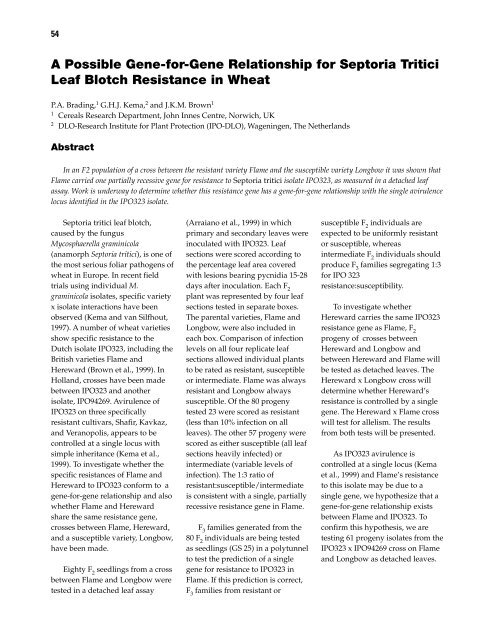Septoria and Stagonospora Diseases of Cereals - CIMMYT ...
Septoria and Stagonospora Diseases of Cereals - CIMMYT ...
Septoria and Stagonospora Diseases of Cereals - CIMMYT ...
You also want an ePaper? Increase the reach of your titles
YUMPU automatically turns print PDFs into web optimized ePapers that Google loves.
54<br />
A Possible Gene-for-Gene Relationship for <strong>Septoria</strong> Tritici<br />
Leaf Blotch Resistance in Wheat<br />
P.A. Brading, 1 G.H.J. Kema, 2 <strong>and</strong> J.K.M. Brown 1<br />
1 <strong>Cereals</strong> Research Department, John Innes Centre, Norwich, UK<br />
2 DLO-Research Institute for Plant Protection (IPO-DLO), Wageningen, The Netherl<strong>and</strong>s<br />
Abstract<br />
In an F2 population <strong>of</strong> a cross between the resistant variety Flame <strong>and</strong> the susceptible variety Longbow it was shown that<br />
Flame carried one partially recessive gene for resistance to <strong>Septoria</strong> tritici isolate IPO323, as measured in a detached leaf<br />
assay. Work is underway to determine whether this resistance gene has a gene-for-gene relationship with the single avirulence<br />
locus identified in the IPO323 isolate.<br />
<strong>Septoria</strong> tritici leaf blotch,<br />
caused by the fungus<br />
Mycosphaerella graminicola<br />
(anamorph <strong>Septoria</strong> tritici), is one <strong>of</strong><br />
the most serious foliar pathogens <strong>of</strong><br />
wheat in Europe. In recent field<br />
trials using individual M.<br />
graminicola isolates, specific variety<br />
x isolate interactions have been<br />
observed (Kema <strong>and</strong> van Silfhout,<br />
1997). A number <strong>of</strong> wheat varieties<br />
show specific resistance to the<br />
Dutch isolate IPO323, including the<br />
British varieties Flame <strong>and</strong><br />
Hereward (Brown et al., 1999). In<br />
Holl<strong>and</strong>, crosses have been made<br />
between IPO323 <strong>and</strong> another<br />
isolate, IPO94269. Avirulence <strong>of</strong><br />
IPO323 on three specifically<br />
resistant cultivars, Shafir, Kavkaz,<br />
<strong>and</strong> Veranopolis, appears to be<br />
controlled at a single locus with<br />
simple inheritance (Kema et al.,<br />
1999). To investigate whether the<br />
specific resistances <strong>of</strong> Flame <strong>and</strong><br />
Hereward to IPO323 conform to a<br />
gene-for-gene relationship <strong>and</strong> also<br />
whether Flame <strong>and</strong> Hereward<br />
share the same resistance gene,<br />
crosses between Flame, Hereward,<br />
<strong>and</strong> a susceptible variety, Longbow,<br />
have been made.<br />
Eighty F 2 seedlings from a cross<br />
between Flame <strong>and</strong> Longbow were<br />
tested in a detached leaf assay<br />
(Arraiano et al., 1999) in which<br />
primary <strong>and</strong> secondary leaves were<br />
inoculated with IPO323. Leaf<br />
sections were scored according to<br />
the percentage leaf area covered<br />
with lesions bearing pycnidia 15-28<br />
days after inoculation. Each F 2<br />
plant was represented by four leaf<br />
sections tested in separate boxes.<br />
The parental varieties, Flame <strong>and</strong><br />
Longbow, were also included in<br />
each box. Comparison <strong>of</strong> infection<br />
levels on all four replicate leaf<br />
sections allowed individual plants<br />
to be rated as resistant, susceptible<br />
or intermediate. Flame was always<br />
resistant <strong>and</strong> Longbow always<br />
susceptible. Of the 80 progeny<br />
tested 23 were scored as resistant<br />
(less than 10% infection on all<br />
leaves). The other 57 progeny were<br />
scored as either susceptible (all leaf<br />
sections heavily infected) or<br />
intermediate (variable levels <strong>of</strong><br />
infection). The 1:3 ratio <strong>of</strong><br />
resistant:susceptible/intermediate<br />
is consistent with a single, partially<br />
recessive resistance gene in Flame.<br />
F 3 families generated from the<br />
80 F 2 individuals are being tested<br />
as seedlings (GS 25) in a polytunnel<br />
to test the prediction <strong>of</strong> a single<br />
gene for resistance to IPO323 in<br />
Flame. If this prediction is correct,<br />
F 3 families from resistant or<br />
susceptible F 2 individuals are<br />
expected to be uniformly resistant<br />
or susceptible, whereas<br />
intermediate F 2 individuals should<br />
produce F 3 families segregating 1:3<br />
for IPO 323<br />
resistance:susceptibility.<br />
To investigate whether<br />
Hereward carries the same IPO323<br />
resistance gene as Flame, F 2<br />
progeny <strong>of</strong> crosses between<br />
Hereward <strong>and</strong> Longbow <strong>and</strong><br />
between Hereward <strong>and</strong> Flame will<br />
be tested as detached leaves. The<br />
Hereward x Longbow cross will<br />
determine whether Hereward’s<br />
resistance is controlled by a single<br />
gene. The Hereward x Flame cross<br />
will test for allelism. The results<br />
from both tests will be presented.<br />
As IPO323 avirulence is<br />
controlled at a single locus (Kema<br />
et al., 1999) <strong>and</strong> Flame’s resistance<br />
to this isolate may be due to a<br />
single gene, we hypothesize that a<br />
gene-for-gene relationship exists<br />
between Flame <strong>and</strong> IPO323. To<br />
confirm this hypothesis, we are<br />
testing 61 progeny isolates from the<br />
IPO323 x IPO94269 cross on Flame<br />
<strong>and</strong> Longbow as detached leaves.









